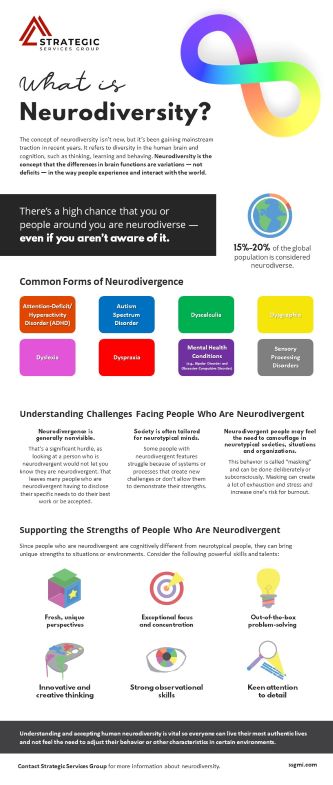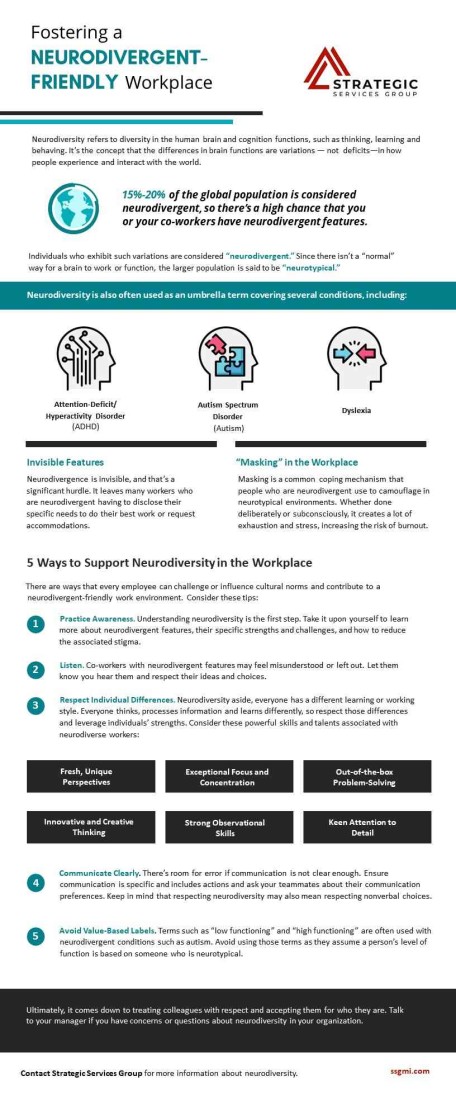Understanding Neurodiversity

The concept of neurodiversity isn’t new, but it’s been gaining mainstream traction in recent years. In 1998, Australian sociologist Judy Singer coined the term “neurodiversity” to recognize that everyone’s brain develops uniquely. Neurodiversity refers to diversity in the human brain and cognition, such as sociability, learning, attention, mood and other mental functions.
Despite increased diversity, equity, inclusion and belonging (DEIB) efforts, the neurodivergent group is often overlooked in hiring and the workplace.
With an estimated 15%-20% of the global population being neurodiverse, this group could be an untapped asset for organizations.
This SSG Insight explains neurodiversity, neurodivergent conditions, strengths and challenges of neurodivergence, and tips for fostering a neurodiverse environment.
What Is Neurodiversity?
Neurodiversity is the concept that differences in brain functioning are normal variations with strengths and weaknesses. It is also often used as an umbrella term covering several conditions or individuals who exhibit such variations can be considered “neurodivergent.” The larger population not considered neurodivergent is said to be “neurotypical.”
Forms of Neurodivergence
Neurodivergence is often used as an umbrella term covering several conditions, including the following:
- Attention-deficit/hyperactivity disorder (ADHD)
- Autism spectrum disorder (autism)
- Down syndrome
- Dyscalculia (difficulty with math)
- Dysgraphia (difficulty with writing)
- Dyslexia (difficulty with reading)
- Dyspraxia (difficulty with coordination)
- Mental health conditions, including bipolar disorder and obsessive-compulsive disorder
- Sensory processing disorders
- Tourette syndrome
In the neurodiversity movement, neuro-differences are typically recognized or appreciated as a social category similar to differences in ethnicity or gender.
Workplace Challenges for Neurodivergent Employees
People who are neurodivergent have differences in the way their brain works. First and foremost, neurodiversity is generally non-visible; someone looking at a neurodiverse person would not immediately know they are neurodiverse. This leaves many neurodivergent workers having to disclose their specific needs to do their best work or request accommodations from their managers and employers.
Additionally, some people who are neurodivergent struggle because of systems or processes that create new challenges or don’t allow them to demonstrate their strengths. For example, they may have challenges fitting in socially, behaving in expected ways or easily adjusting to change. Some common and challenging symptoms of neurodivergence include:
- Atypical physical behaviors (e.g., expressing tics and shouting at unexpected times)
- Atypical responses to sensory input (e.g., sensitivity to light, sound, heat, cold or crowds)
- Inflexibility or inability to adapt or change
- Learning challenges (e.g., difficulty focusing or reading)
- Social communication difficulties
- Speech and language challenges
These symptoms are simply examples since specific challenges hinge on the individual’s form of neurodivergence.
In general, society is often tailored for neurotypical minds. As a result, neurodivergence can often be misunderstood, making people who are neurodivergent feel the need to camouflage in neurotypical societies, situations and organizations. This complex behavior is called masking and can be done deliberately or subconsciously. One of the most significant issues with masking is that it creates a lot of exhaustion and stress and can increase the risk of burnout.
Masking differs between individuals, but the behavior is often triggered by an inaccessible environment or a need to fit in, avoid judgment and have a sense of belonging. Ultimately, masking and being unable to be authentic can have serious mental health implications.
Benefits of a Neurodiverse Workforce
DEIB programs have become standard practice for many organizations. However, such efforts may fall short if they don’t account for a neurodiverse workforce. Along with successfully delivering on DEIB initiatives, there are specific benefits of employing neurodiverse teams.
Consider the following general but powerful skills and talents of those who are neurodivergent:
- Fresh, unique perspectives
- Exceptional focus and concentration
- Out-of-the-box problem-solving skills, which support innovative and creative thinking
- Strong observational skills and keen attention to detail
While people who are neurodivergent tend to excel in those areas, it’s vital to remember that every person is different. The strengths of these individuals have an opportunity to shine when they’re given the proper credit and support.
Fostering Neurodiversity
There are ways you and every person can challenge or influence cultural norms and contribute to a neurodivergent-friendly environment. Consider these tips for fostering neurodiversity:
- Practice awareness. Understanding neurodiversity is the first step. Take it upon yourself to learn more about neurodivergent features, their specific strengths and challenges, and how to reduce the associated stigma.
- Listen. People with neurodivergent features may feel misunderstood or left out. Let others know you hear them and respect their ideas and choices.
- Respect individual differences. Regardless of neuro-differences, everyone has a different learning or working style. Everyone thinks, processes information and learns differently, so respect those differences and leverage individuals’ strengths.
- Communicate clearly. There’s room for error if communication is not specific or clear enough. To reduce potential confusion, ensure communications are specific and include actions so the recipient understands the ask or task. For example, in the workplace, ask your teammates or direct reports what their communication preferences are. Keep in mind that respecting neurodiversity may also mean respecting nonverbal choices.
- Avoid value-based labels. Terms such as “low functioning” and “high functioning” are often used with neurodivergent conditions, such as autism. Avoid using those terms, as they assume a person’s level of function is based on neurotypical function.
Summary
People who are neurodivergent may spend significant time adjusting to their environment or managing their social impressions. While neurodiversity has its strengths, it also comes with challenges individuals may need to navigate.
Understanding and accepting human neurodiversity is important so everyone can live their most authentic lives and not feel like they need to adjust their behavior or other characteristics in certain environments. Ultimately, it comes down to treating others with respect and accepting them for who they are.



 Prev
Prev

